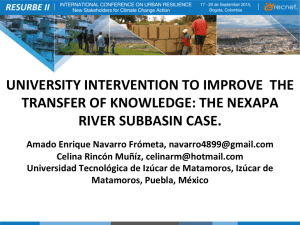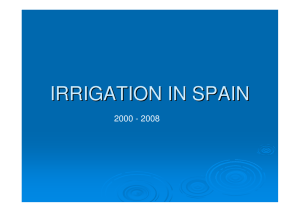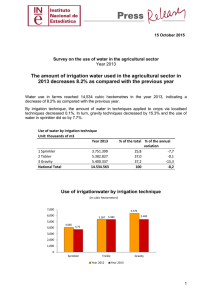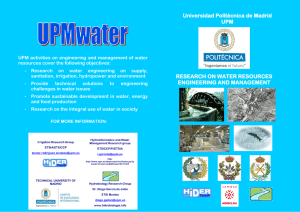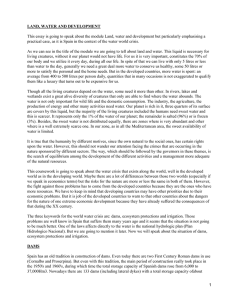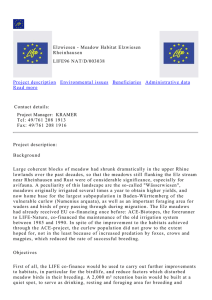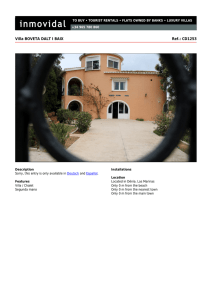Water harvesting and agricultural land development
Anuncio
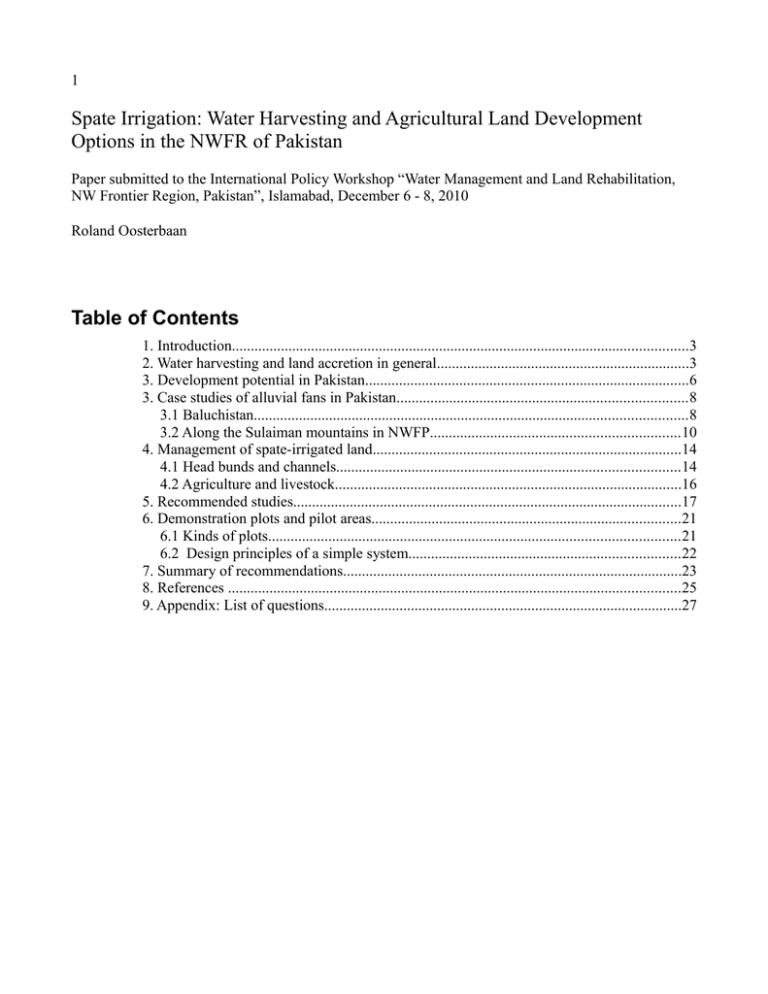
1 Spate Irrigation: Water Harvesting and Agricultural Land Development Options in the NWFR of Pakistan Paper submitted to the International Policy Workshop “Water Management and Land Rehabilitation, NW Frontier Region, Pakistan”, Islamabad, December 6 - 8, 2010 Roland Oosterbaan Table of Contents 1. Introduction.........................................................................................................................3 2. Water harvesting and land accretion in general...................................................................3 3. Development potential in Pakistan......................................................................................6 3. Case studies of alluvial fans in Pakistan.............................................................................8 3.1 Baluchistan...................................................................................................................8 3.2 Along the Sulaiman mountains in NWFP..................................................................10 4. Management of spate-irrigated land..................................................................................14 4.1 Head bunds and channels...........................................................................................14 4.2 Agriculture and livestock............................................................................................16 5. Recommended studies.......................................................................................................17 6. Demonstration plots and pilot areas..................................................................................21 6.1 Kinds of plots.............................................................................................................21 6.2 Design principles of a simple system........................................................................22 7. Summary of recommendations..........................................................................................23 8. References ........................................................................................................................25 9. Appendix: List of questions...............................................................................................27 2 Water Harvesting and Agricultural Land Development Options in the NWFR of Pakistan Cover image Overview of spate-irrigated areas (Rod-Kohi, Sailaba) in Pakistan (Ref [1]) 3 1. Introduction The region under discussion is vast and covers a wide swath of territory stretching all along the foot of the Sulaiman Mountains (bordering Afghanistan) sloping down to the Indus River. The workshop aims at setting guidelines for the future economic and social development of the region, including engaging the tribal people in remunerated labor-intensive repair and development of their own environment which has seriously degraded in the past. The degradation was partly due to the destructive forces of erosion, and in particular to the destructive flash floods which occur during the region's summer (often violent) convectional showers and which periodically ravage the region. Another reason is the socio-political instability in the region. The workshop also envisages defining certain “Demonstration plots” or “Pilot sites” so that both during the Workshop and afterward a suitable Project Proposal can be prepared on solid ground about what can be done in determining early on what works and what doesn't before committing large-scale resources to any sort of follow-on effort. Socially, the project objective is generating in the tribal people a sense of ownership and responsibility for their land which has not been the case for many years. 2. Water harvesting and land accretion in general Along the foot slopes of mountain ranges bordering flat land or river plains one often finds river or water course deposits and alluvial fans that offer considerable agricultural potential. In semi-arid regions the water courses and rivers provide a source of water for irrigation of crops as well. Here, the rainfall in the mountainous areas is usually higher than in the plains owing to orographic uplifting of the air masses. Consequently, the scarce rainfall in the plain can be supplemented by runoff from the hills to facilitate a form of agriculture that would otherwise hardly be possible. Globally the alluvial fans differ greatly in size, slope, and grain size of the sediments brought in by the the rivers and water courses. Also within each fan, the grain size varies, the courser materials (stones, gravel, sand) being deposited close to the apex of the fan, where the river or watercourse enters the plain, and the finer materials (silt and clay, if any) further away. The following map of Pezu Pai, near Tank, shows a typical example. 4 Map of Pezu Pai, near Tank Also the flow regime of the runoff varies greatly between the fans and within the fans. The variation between the fans is caused by the difference in rainfall regime and the size and shape of the catchment area. The variation within the fans finds its origin in the different distribution patterns of the incoming water over the fan itself. Usually the incoming water spreads itself out over the fan through water channels branching off from the main stream in all manner of patterns. In semi-arid regions the runoff is often flashy (torrential), especially when the catchment area is relatively small, which leads to unpredictability of the available water resources, difficult handling of the water resource, and predominantly course sediments. All these factors are conducive to a reduced agricultural potential. 5 Different hydrologic conditions and shapes of alluvial fans Alluvial fan in a dry climate in Iran with irrigated agriculture along the border using water coming down from the hills Evergreen alluvial fan in Italy owing to plenty of rainfall Conclusion The rainfall and runoff regime determine the characteristics of alluvial fans and their potential for agricultural use to a great extent. 6 3. Development potential in Pakistan Table 1 Potential spate irrigation areas in Pakistan Province Potential area Potential (MA) water (MAF) Ratio water : area Realistic (*) potential area (MA) Federal 0.67 2.84 4.2 0.67 NWFP 2.13 4.56 2.1 1.07 Punjab 1.41 2.71 1.9 0.63 Sind 1.36 0.72 0.5 0.16 11.56 7.85 0.7 1.93 Balochistan Total 17.13 18.68 1.1 4.95 Ref: Master feasibility studies for flood management of hill torrents, NESPAK, 1998 (*) Assuming critical water:area ratio of 4.2, as in the Federal territories, the realistic potential area is obtained from the potential area (column 2) multiplied with the water:area ratio (column 4) divided by 4.2 Table 2. Potential and actually cultivated spate area in Pakistan Province Number of major Potential area torrents (mha) Actual spate area cultivated in 1999 (mha) Federal - 0.271 - NWFP 25 0.862 0.109 Punjab 17 0.571 0.048 Sindh - 0.551 0.011 Balochistan 17 4.680 0.185 Pakistan 6.935 0.343 Ref: NESPAK, 1988; Agricultural census of Pakistan, 2000 7 Table 3. Ratio of realistic potential area and actually cultivated spate area Province Realistic potential area (mha) Actual spate area cultivated in 1999 (mha) Ratio actual : potential Federal 0.136 - - NWFP 0.431 0.109 0.25 Punjab 0.258 0.048 0.19 Sindh 0.067 0.011 0.16 Balochistan 0.780 0.185 0.24 Pakistan 1.67 0.343 0.21 Conlusion There appears to be a large potential for spate irrigation development; on average a five-fold increase seems feasible. Corroboration1 Quotation from Ref [2] (Flood management of Kaha Hill torrent, 1992) “In the Pachad area basin irrigation by hill torrents has been practiced since centuries, These fields are evenly terraced and bunded so as to store about 1 m depth of water. In the past, the basin irrigation was very effective and used to irrigate an area of about 0.28 million ha. A substantial amount of flood water was thus utilized in basin irrigation. Due to changes in the socio-economic conditions during tha past 3 decades, the system has gradually deteriorated, and reduced the irrigation to less than 0.04 million ha. At present, not even the normal floods are effectively controlled, and they cause considerable damage in irrigated areas of the DG Khan Canal and the Dajal Branch. The practice of spate-irrigation (Rod-Kohi, Sailaba) is now one seventh of what is was before and the flood damage has increased. The Rod-Kohi system is not only productive in the sense that it provides irrigation and agricultural crops, but it is also protective as form of flood-control. There is ample scope for restoration of abandoned Rod-Kohi systems. Corroboration2 Quotation from Ref [3] (Spate Irrigation in NWFP of Pakistan, 2003): “According to estimates of local farmers even today 20 to 25% of the spate flow in DI Khan and Tank districts is utilized an the rest is drained into the Indus River.” Although not all torrent water is usable due to its unpredictable behavior, there is still ample scope for more water harvesting. 8 Note Given the neglected state of the older traditional schemes in the larger commands of hill torrents, there is no doubt that there are also many possibilities for new developments of Rod-Kohi areas in the commands of the smaller Nallahs which have hitherto not been used. Recommendation 1. It is recommended to inititate a socio-economic survey to detect amongst the population the reasons for deterioration of the Rod-Kohi systems and reduced water use as reported above. 3. Case studies of alluvial fans in Pakistan 3.1 Baluchistan A series alluvial fans near Khuzdar, Baluchistan, is used for agriculture under the “sailaba” system together with “Karezes” (“Qanats”). In the figure it is seen that “dikes” (“bunds”, “embankments”) have been constructed at the foot of the fan to retain the water that is diverted from the streams that are spreading out over the fan from the main water course after it emerges from the hills. The areas just above the bunds are silting up as the flowing water carries soil particles that are deposited in the “receptacles” formed by the bunds. Hence, the “Sailaba” system serves both a “water harvesting” and a “land accretion” purpose. Due to the land accretion, behind the bunds, the landscape is transformed into a terraced area (Reference [4]). Sketch of the use of alluvial fans in Baluchistan for irrigated agriculture 9 The upper part of the alluvial fan usually contains permeable deposits of course sediment particles like stones, gravel and course sand. Therefore, the waters carried by the river and the streams infiltrate into the soil forming aquifers in which the water is stored. In Baluchistan, these aquifers are tapped by “Karezes” which provide a continuous water supply in the dry season. Here, it is possible to have yearround agriculture. Bund made from local earth serving as a “receptacle” (“retention basin”, “compounding basin”) for water and soil Terraced landscape in Baluchistan Conclusion from the case study Baluchistan Expertise on water harvesting and land development by bunding (embanking) and terracing is already available in Pakistan and the technique provides a viable option to repair degraded lands or to create new lands for sustainable agriculture. The technique also helps in flood control. Recommendation 2. Indigenous expertise is to be engaged and local consultants are to be employed when undertaking a water harvesting and land development project elsewhere. 10 3.2 Along the Sulaiman mountains in NWFP An impression of alluvial fans and Rod-Kohi practices can be obtained from the space images offered by NASA World Wind as shown below. The Indus River is clearly visible as well as the area of the Chashma barrage. To the west of the barrage there is a large irrigated alluvial fan. The purple line running from almost the middle of the picture in an approximately north-south direction along the Indus River corresponds with the foot of the Sulaiman mountains. Here one notices many green tracts of land indicating areas irrigated from “Zams” and “Nullahs” originating in the mountains and related to alluvial fans. Image from space obtained from NASA World Wind 11 Google Earth picture of a Rod-Kohi system just south of Kolachi. Recommendation 3. Satellite imagery is to be used to identify the tracts of land that may be selected for closer inspection and reconaissance with the aim to evaluate water harvesting and land development options. See also Reference [5]. 12 The following map provides interesting details. Map from the reconnaissance soil survey report of Dera Ismail Khan 1969 13 Legend used in the map: 1. Land with a very high economic potential under irrigation 2. Land with a very high economic potential if irrigation can be provided 3. Land with a high economic potential under irrigation 4. Land with a high economic potential if irrigation can be provided 5. Land with a moderate economic potential under flood-watering 6. Land with a low economic potential under dry-farming 7. Land with a moderate economic potential for grazing and wood-land 8. Land with a low economic potential for grazing 9. Unproductive land Recommendation 4. For the Water Harvesting and Agricultural Land Development Project the map from 1969 would need to be updated and similar maps would need to be prepared for the the areas to be taken up. Especially the lands in categories 2, 4 and 5 need to be identified before detailed project planning is to be taken up. A description of watershed characteristics may be included. Owing to the courseness of the sediments along the piedmont of the mountain ranges where alluvial fans are formed, and the high infiltration capacity of these sediments, there may be a considerable recharge from runoff water to the aquifers which under the regional conditions normally have a high transmissivity and are therefore exploitable. The recharge can be further promoted by storing water in bunded fields. The DIK soil survey report mentions that tube-wells and Persian wheels are used to exploit the groundwater for irrigation and other purposes. Recommendation 5. In areas where the Water Harvesting and Agricultural Land Development Project will be actively reclaiming land, attention need to be given to the possibility of groundwater use to supplement the water harvested from to torrents for more secure agricultural production. 14 4. Management of spate-irrigated land 4.1 Head bunds and channels Traditionally, the main water course and the principle branches of the alluvial fan are dammed by breachable bunds (Sads, Ghandas). In the Gomal Zam region there are 128 head bunds, in the Choudwan Zam command 90, in Tank Zam area 61, and in the Sheihk Haider Rod-Kohi 18 (Ref. [3]) Smalller Nullahs (that unlike the Zams have no perennial water) may have a much smaller number or even only one head bund. The head bunds are located at places where natural channels (Wahs) take off from the main channels to force the water into these Wahs serving the irrigated lands. At a flood event, and after all irrigation requirements of the land holders along the first Wah have been fulfilled, the bund is breached and the water passes on to the next head bund where water is diverted for irrigation along the second Wah. This procedure continues until the flood comes to an end. The distribution system is called Soraiba-Paina (Head-Tail) and it entails that upstream water users have preferential rights. It may very well be that land holders have both upstream and downstream plots. One also speaks of Haqooq Wahs (priority) and non-Haqooq Wahs (Ref. [13]), but this refers more to perennial water. After the flood has ceased, the head bunds are restored to await the next flood. The water users along the Wahs have well established, but often not written, maintenance duties with respect to the head bund and the Wah. To some extent, the Government assists in the maintenance by providing services of subsidized bulldozers, as reported for Baluchistan (Ref. [7]), where the bulldozers were obtained with grants from international donors. The number of bulldozers may be too small to provide assistance everywhere. In the DI Khan district it was reported that the Agricultural Engineering Department had about 10 bulldozers while according to magnitude and scale of work at least 100 bulldozers are required throughout the year [[Ref [11]). Modern, permanent, structures have been erected but they were not entirely successful .The failure rate of 74 head works constructed in Balochistan was very high (>60%) due to sedimentation, discrepancy with indigenous water rules and water sharing arrangements, lack of flexibility of the structures to cope with extreme floods. Without proper maintenance the still functional works could become out of use. (Ref. [9] and [10]). 15 Other noteworthy detailed experiences on head works 1. The head bunds also have an important function in the formation of reservoirs for household and drinking water. (Ref. [9]). 2. High flows breach earthen diversion structures, deprive the cultivators from the use of this water and the flood water rushes downstream and causes damages (Ref. [9]), but the same may occur to modern structures. Wahs may change their course every so often. Owing to the inherent dynamics of alluvial fans, the presence of permanent repair teams is a necessity. 3. Quotations from Ref. [12] referring to Kachhi District in Balochistan: The Pak-German self-help project has constructed a very successful ring dam (earth bund) on the site of an old Ghanda at Jalal Khan near Bagh. Resuccitation of traditional practices is preferred over big engineering works (lower costs, no siltation problems) . On steeper slopes bundats (bunds) are 1.5 to 2 m high. This gives mechanical strength against washing away and a capacity to impound silt. Rat holes can be a problem. In open plains the bunds are only 30 cm high, but they are fragile and often swept away 4. Ref. [13] concerns the final report of the eight year long research project on spate irrigation in Pakistan by Water Resources Research Institute - describing spate systems (Rod Kohi) in the various provinces and practical research results on improved water management at canal and field level, on agronomic measures and on improved drinking water supply in the spate areas. 5. Punjab Irrigation Department has built various flexible structures comprised of stones in wire crates (gabions) for bed control and diversion of flood flows into wahs of Kaha Hill Torrent. These structures are cheap in cost and functioned satisfactorily (Ref. [2]). 6. Realistic estimation of discharge and runoff is the major determinant which forms the corner stone of all flood management projects (Ref. [2]). 7. By making retention ponds and considering underground storage, not only the water for drinking purpose but also for the critical periods of crops can be stored (Ref. [9]). 8. Deterioration of the vegetative cover through overgrazing by nomadic flocks and cutting of trees by sedentary people has aggravated the the flood damage caused by the hill torrents (Ref. 14]). 16 4.2 Agriculture and livestock According to Ref. [15], the distribution of size of holdings for Daraban Zam in DI Khan district is the following: Farm size % of households % sheep and goats < 5 acres 60.4 65.4 5 – 12.5 acres 18.6 17.7 12.5 – 25 acres 6.5 6.8 > 25 acres 14.5 10.2 (Source: Agricultural Census of NWFP, 1990) However, Ref. [14] reports that in DI Khan the majority of the farmers have 10-20 ha, either as property or in lease. Important agricultural characteristics: Crop rotation According to Ref. [14], 31% of the households in DI Khan said that 80% of their land was fallow in the last five years during rabi season. During summer less than 7% was cultivated. Also in Baluchistan, the cropping intensity varies from year to year according to the hydrologic conditions, but it appears that the cropping intensity is higher. In Kachhi District, cropped areas are on the average 30-40% of the holding (Ref. [12])). Land, on the one hand, may be left fallow involuntarily due to scarcity of water or land degradation, on the other hand fallowing is an important part of the essential crop rotation system. Crop calendar Kharif (monsoon) water is available from June to September. Crops shown during Kharif are mainly sorghum and mung bean, often as inter-cropping (80% of the households do so), but rapeseed (mustard) and millet is also sown The stalks are usually grazed. Rabi (spring) crops using the the rains of March and April are mainly wheat followed by gram or chickpea. Sailaba wheat yields typically 600 kg grain per ha. A small minority of crops are melons, barley and Guar (vetch). Livestock Livestock are a critical component of the farming system in Baluchistan (Ref. [12]). Sorghum straw is a major fodder. Oats and barley are green fodders. Rape fodder is also used. Livestock farmers (85%) in DI Khan migrate twice a year to the irrigated areas of CBRC (Ref. [14]). The main grazing sources are bushes and trees. In Baluchistan agriculture is primarily based on fodder sorghum and livestock. Bullock breeding is responsibility of the women (Ref. [8]). 17 5. Recommended studies Recommendation 6. For repair of degraded areas and development of new projects it would be useful to establish in the existing areas irrigated from torrents the relation between water yield and cultivable area on the one hand and size of the catchment on the other. The relation may somewhat scattered due to differences in hydrologic charcateristics of the catchments and it may be variable from year to year depending on the rainfall regime, but with some interpretation it could yield an instrument (see figure) for the design of future works on the basis of only size of watershed, which is a characteristic that can be surveyed with realative ease from existing maps or satellite imagery. The following references provide information and equations for such relationships: http://www.fao.org/docrep/u3160e/u3160e06.htm http://www.hydrologynz.org.nz/downloads/JoHNZ_1967_v6_2_Taylor.pdf Recommendation 7. Students going for their MSc or PhD thesis could be successfully employed for these kind of studies. Assuming that a complete inventory of the piedmont lands along the foot of the Sulaiman mountains is not available, the Project would need to embark on such an inventory of potential water harvesting and land development schemes. Recommendation 8. It would greatly help to get national, and perhaps international support (if so desired), for the ideas of restoring the degraded lands in NWFR, and initiate flood control, water harvesting and land accretion projects, that a classification is made of existing and potential sites where the ideas can be implemented. Such a classification may entail: 18 1 - Sites with reasonably well functioning agricultural irrigation schemes from torrents (“nullahs” and “zams”) along the piedmonts that do not need immediate improvement but that may serve as a knowledge source for the other sites 2 - Sites with imperfectly functioning agricultural irrigation schemes from torrents (“nullahs” and “zams”) along the piedmonts that require improvement of the existing infrastructure and management 3 - Sites that have been in use in the past for irrigated agriculture from torrents (“nullahs” and “zams”), but that are abandoned and neglected and need to be fully restored 4 - Sites that have not been taken up for agricultural development in the past but that may have new potential for development of irrigated agriculture from torrents (“nullahs”). 19 A more detailed sketch of land use was found in the same report: Land use along Vehowa nullah, from the reconnaissance soil survey report of Dera Ismail Khan, 1969 Conclusions A. Like in Baluchistan, also along the foot of the Sulaiman mountain range, embanked and torrent-watered lands do exist and provide healthy agriculture. Local experience can be found here too. B. The land development pattern is intricate and depends entirely on the local topography and water resources. Hence it varies from place to place. Recommendation 9. To undertake the repair of degraded lands or the development of new lands the local conditions must be well understood and the works need to be designed accordingly. Detailed information on the hydrological and topographical conditions of areas selected by the project is to be obtained beforehand. A similar sketch as for the Vehowa nullah was encountered in the soil survey report for an area near Takwara: 20 Conclusions A. When comparing this sketch with the previous one, an impression is obtained of the variety of environmental conditions prevailing in the region of study. Therefore, it will not be possible to apply standard design principles: the solutions must be tailor-made. B. The social organization may also be quite different in the various areas. The success of the Water Harvesting and Agricultural Land Development Project will not only depend on the proper incorporation of the natural/physical conditions, but also on the socio-organizational situation, land and water use rights, community spirit and the like. Recommendation 10. A. It is recommended to involve expertise on socio-organizational aspects of the various rural communities that are to be included in the project. B. It is recommended to investigate the possibility for participation of women in the project. The women in area are industrious but the scope of skilled employments open to them is limited, except domestic needle-work and their share in agriculture work Women rights in land and water are considered as an Islamic obligation, but before the 70’s small land owners were hesitant to give them the share in land. After 2000 the trend has changed regarding female education, role in politics, share in land and jobs because of the exposure and interaction with different communities (Ref. [8]). C. To develop the community spirit for the sake of sustainability of the new developments it is recommended to initiate the formation of “water user associations” as has successfully occurred in many irrigation projects around the world as for example in Mexico (Reference [5]). See also Reference [6] for water user organizations in Pakistan. D. The associations might be made eligible to a subsidy for the works to be undertaken after after official approval of the plans. In the early stages they would need guidance from an experienced team. 21 6. Demonstration plots and pilot areas 6.1 Kinds of plots There may be four kinds of demonstration areas: 1 – demonstration areas in sites that are functioning well but could use expansion with new infrastructure in line with the existing infrastructure 2 – demonstration areas in sites where water harvesting is still practiced but the systems are in need of upgrading of the existing infrastructure 3 – demonstration areas in abandoned sites where water harvesting has been practiced some time in the past and the systems need to be restored by tracing the old infrastructure and reshaping it possibly with additional new infrastructure 4 – demonstration areas in potential new sites that have never been taken up for water harvesting and land development in the past and could be provided with new infrastructure Example of a barren recent alluvial fan where a demonstration area of the 4-the kind could be considered Locations of the 4-th kind concern virgin areas and it may be of interest to have a simple pilot area design at hand to perform experiments and obtain a experience. A proposal for the principles upon which such a design may be based is is shown in the following figure. The proposal certainly needs more thought and study before it reaches the state of maturity. Eventually the proposal may reach a stage in which it is also applicable to sites of the 1-st and 3-rd kind. 22 Principles of a two-bund system for water harvesting and land accretion 6.2 Design principles of a simple system The principles illustrated in the previous figure are based on the idea to start experimenting with water harvesting and land development in virgin land at a small scale to gain experience before embarking on larger and complete projects. As shown in the preceding pages, the traditional bunding is done more or less scattered over the area. This sort of development is typical for areas where the reclamation activities have taken generations before the entire area was brought under development. It is likely that, over the generations, the ideas and concepts have undergone changes owing to new experiences and to alterations in the status of landownership and water use rights. It is also quite well thinkable that the most promising reclamations were taken up first and the marginal ventures later. When embarking on a modern new project, it does not seem strictly necessary to adhere to the traditional more or less random ad-hoc approach and one could adopt a more systematic pattern of development. Technical notes: The technical details of the two-bund system might be as follows. 1 - The 1st bund slopes gently downward away from the water course, say at a 1 per 1000 slope 2 - The 2nd bund slopes gently downward towards the water course at a similar slope. 3 - The bunds, therefore, are not parallel to each other. 4 - The length of the bunds may be several hundred meters and their height may be about 1 m. 5 - The spacing between the bunds could be 100 m. In strongly sloping land this distance can be reduced and in relatively flat land the distance may be increased. 6 - The bunds may be constructed with cobbles, stones, gravel and course sand found nearby and possibly from the course soil material just downslope of it. 7 - The water course is dammed at the crossing with the first bund to divert the flow to the area above the bund. 8 - The bunds may have wings at their outflow sides to form basins or “receptacles” to promote the storage of water, to reduce the flow velocity and to enhance the siltation. 23 Hydrological notes 1 - When the water course carries relatively little water, all of it may be stored behind the 1st bund, including the silt brought with it. 2 - When the water course carries a modest amount of water, it will spill over from the 1st bund into the 2nd and the spillage may be stored totally here, including the remaining silt. 3 - When the water course carries a relatively high amount of water, a part will be stored behind the 1st bund, another part behind the 2nd bund while the remainder will be returned to the water course through the open outlet structure at the crossing of the water course with the the 2nd bund. 4 - The main reason of the gentle slope of the 2nd bund towards the water course and the outlet structure is to guarantee the excess waters will safely be returned to the water course. Otherwise the spillage from the 2nd bund may follow a new path downstream where there was no flow before and cause damage to environment and property that is unprepared to receive this flow. General note It may take a few years before the newly reclaimed areas become fit for agricultural production. To keep the interest of the land user vivid, early planting of bushes and trees may be undertaken to speed up the process and to provide fodder (leaves) for livestock. 7. Summary of recommendations Recommendation 1. It is recommended to inititate a socio-economic survey to detect amongst the population the reasons for deterioration of the Rod-Kohi systems and reduced water use. Recommendation 2. Indigenous expertise is to be engaged and local consultants are to be employed when undertaking a water harvesting and land development project elsewhere. Recommendation 3. Satellite imagery is to be used to identify the tracts of land that may be selected for closer inspection and reconaissance. See also Reference [3]. Recommendation 4. For the Water Harvesting and Agricultural Land Development Project the map from 1969 would need to be updated and similar maps would need to be prepared for the the areas to be taken up. Especially the lands in categories 2, 4 and 5 need to be identified before detailed project planning is to be taken up. A description of watershed characteristics may be included. Recommendation 5. In areas where the Water Harvesting and Agricultural Land Development Project will be actively reclaiming land, attention need to be given to the possibility of groundwater use to supplement the water harvested from to torrents for more secure agricultural production. Recommendation 6. For repair of degraded areas and development of new projects it would be useful to establish in the existing areas irrigated from torrents the relation between water yield and cultivable area on the one 24 hand and size of the catchment on the other. The relation may somewhat scattered due to differences in hydrologic charcateristics of the catchments and it may be variable from year to year depending on the rainfall regime, but with some interpretation it could yield an instrument (see figure) for the design of future works on the basis of only size of watershed, which is a characteristic that can be surveyed with relative ease from existing maps or satellite imagery. Recommendation 7. Students going for their MSc or PhD thesis could be successfully employed for these kind of studies. Recommendation 8. It would greatly help to get national, and perhaps international support (if so desired), for the ideas of restoring the degraded lands in NWFR, and intiate flood control, water harvesting and land accretion projects, that a classification is made of existing and potential sites where the ideas can be implemented. Such a classification may entail: 1 - Sites with reasonably well functioning agricultural irrigation schemes from torrents, “nullahs” and “zams” along the piedmonts that do not need immediate improvement but that may serve as a knowledge source for the other sites 2 - Sites with imperfectly functioning agricultural irrigation schemes from torrents, “nullahs” and “zams” along the piedmonts that require improvement of the existing infrastructure and management. 3 - Sites that have been in used in the past for irrigated agriculture from torrents, “nullahs” and “zams”, but that are abandoned and neglected and need to be fully restored. 4 - Sites that have not been taken up for agricultural development in the past but that may have new potential for development of irrigated agriculture from torrents, “nullahs” and “zams”. Recommendation 9. To undertake the repair of degraded lands or the development of new lands the local conditions must be well understood and the works need to be designed accordingly. Detailed information on the hydrological and topographical conditions of areas selected by the project is to be obtained beforehand. Recommendation 10. A - It is recommended to involve expertise on socio-organizational aspects of the various rural communities that are to be included in the project. B - It is recommended to investigate the possibility for participation of women in the project. The women in area are industrious but the scope of skilled employments open to them is limited, except domestic needle-work and their share in agriculture work Women rights in land and water are considered as an Islamic obligation, but before the 70’s small land owners were hesitatant to give them the share in land. After 2000 the trend has changed regarding female education, role in politics, share in land and jobs because of the exposure and interaction with different communities (Ref. [8]). C - To develop the community spirit for the sake of sustainability of the new developments it is recommended to initiate the formation of water user associations as has successfully occurred in many irrigation projects around the world as for example in Mexico (Reference [5]). See also Reference [6] for water user organizations in Pakistan. D - The associations might be made eligible to a subsidy for the works to be undertaken after after official approval of the plans. In the early stages they would need guidance from an experienced team. 25 8. References 1 - The potential for the development of spate irrigation systems in Pakistan. Shahid Ahmad and Frank van Steenbergen http://www.spateirrigation.org/pakistan_network/documents/1_potential_spate_irrigation_spate_notes_LQ.pdf 2 - Feasibility studies for flood management of Kaha Hill Torrent NESPAK, HARZA, Z&A, march 1990 http://www.spate-irrigation.org/librar/documents/FloodProtectionSectorProjectFeasabilityStudiesforFloodManagementKahaHillTorrents_1992.pdf 3 - Spate Irrigation in NWFP of Pakistan, 2003 http://www.spate-irrigation.org/pdf/spateinnwfp.pdf 4 - R.J Oosterbaan, 1982, Modern interferences in traditional water resources in Baluchistan. In: Annual Report 1982, p. 23-33, International Institute for Land Reclamation and Improvement (ILRI), Wageningen, The Netherlands. Reprinted in Water Research Journal (1983) 139, p. 53-60. Also reprinted in Water International 9 (1984), p.106- 111. Elsevier Sequoia, Amsterdam. On line: http://www.waterlog.info/pdf/baluchistan.pdf 5 - Land Cover Assesment and Monitoring, Pakstan. ICIMOD-UNEP report 1988. The report uses NOAA-AVHRR satellite data. 6 - Gorriz, Cecilia M., Subramanian, Ashok, and Simas, Jose. Douglas Olson (1995) (1995-12-31). Irrigation Management Transfer in Mexico. World Bank Publications. ISBN 9780821333303. . http://books.google.com/books? id=O1qUqqDpU1EC&dq=world+bank+irrigation+mexico&pg=PP1&q=world+bank+irrigation+mexic o&cd=1&hl=en#v=snippet&q=world%20bank%20irrigation%20mexico&f=false 7 - Water user organizations in Pakistan http://www.intl.hiroshima-cu.ac.jp/~nakashim/Nakashima/Pak.IDJ.pdf 8 - Balochistan Minor Irrigation and Agricultural Development Project, 1993. Chandia flood irrigation scheme, feasibility study. Sir William Halcrow & Partners, ULG Consultants, Euroconsult, NESPAK. http://www.spate-irrigation.org/librar/documents/ChandiaFeasibilityReport-part1.pdf 26 9 - Hill torrents Management for Increasing Agricultural Activity in Pakistan. Mohsin Nawaz, Mooyoung Han http://www.pcrwr.gov.pk/Journals/Vol.no.%209%20%281%29/p.25-34%20Farmers%20Irrigation %20Practices--RAFIQ%20CH.pdf 10 - Organized farmers: spate irrigation in Balochistan. Frank van Steenbergen http://www.spate-irrigation.org/librar/spatesoc.htm 11 - Asian Development Bank (ADB), Consultants report Pakistan: Additional Works for the preparation of hill torrent management plan http://www.spate-irrigation.org/librar/documents/CRBCHillTorrentPlan.pdf 12 - Diagnostic study of farming systems in Baluchistan: Kachhi District Ian MacDonald and Associates (1989?) http://www.spate-irrigation.org/librar/documents/AgronomyKacchiPakistan.pdf 13 - Rod-Kohi system development and management in Pakistan - a national project Water Resources Research Institue, National Agricultural Reserach Centre, Islamabad, Augus 2001 D.I.Khan, D.G.Khan, Barkhan, Tana Bouls Khan. http://www.spate-irrigation.org/pdf/Overview%20of%20Rod%20Kohi%20Project%20WRRI.pdf 14 - Findings of a review study on agriculture and livestock farming in Rod Kohi, D.I.Khan M.Akmal and G.Habib, May 2002 Agricultural University of Peshawar, May 2002. 15 - History of Daraban Zam (DI Khan) Fahim Iqbal (Veer) http://www.spate-irrigation.org/librar/documents/HistoryofDrabanZamDIKhan_000.doc 27 9. Appendix: List of questions List of a number of questions, issues to be addressed, prospective problems to be tackled during our discussions in Islamabad from 6-8 December. A number of these 'issues' could be linked or directly related to the work which needs to be carried out (immediately following the conclusion of the Workshop), especially in the various 'Demonstration Sites' that have been identified. Sites in abandoned areas Sites in virgin land 1. Why was the area abandoned? Why has the area never been used? 2. Anyting against re-instatement? Would it be an attractive site for new delevopment? 3. What were the the irrigation techniques used previously? Which irrigation techniques could be employed? 4. What crops were grown? 5. What was the long-term economical value of the crop production? General questions 1. Is sufficient water available? 2. Are the soil conditions favourable? 3. Can eventual torrents be controlled? 4. Does the flood water bring a satisfactory amount of sediments for soil enrichment? 5. Is it feasible to create new soil by siltation techniques? 6. What agricultural use is to be made of the land? 7. Who are the land owners? 8. What is the economical position of the landowners? 9. Are the land owners interested in co-investment in the land? 10. What are the risks involved and to what extent are (un)acceptable? 11. Can the landowners be organized into a Rod Kohi association? 12. What investments are required to make the land cultivable? 13. What additional investments are required without which the project would not be sustainable? 14. What are the requirements for proper project management, including personnel, equipment and financing?
